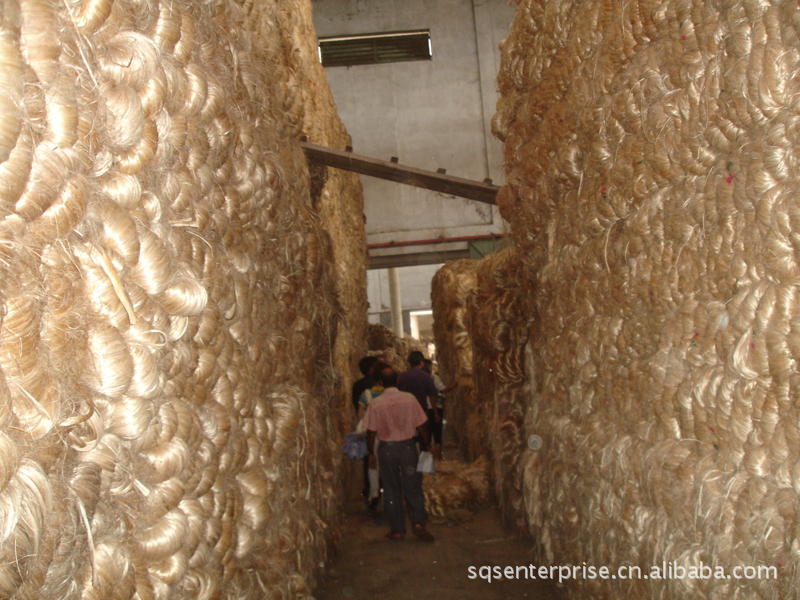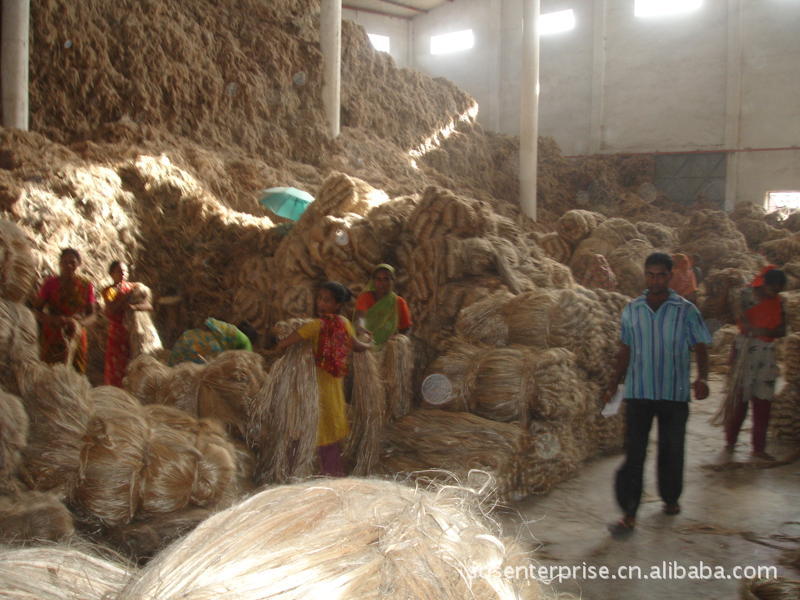SQS ENTERPRISE
主营产品:
SQS ENTERPRISE
主营产品:

2023年06月23日 08:19
品种 |
黄麻纱线 |
回潮率 |
0.5% |
含杂率≤ |
1.0 |
纤维长度≥ |
160 |
纤维强力≥ |
255 |
外观品质 |
一等 |
产地/厂家 |
孟加拉 |
属性 |
黄麻 |



Jute has gained an advantage as being an eco-friendly option instead of poly and paper bags as polybag are made from petroleum and are non-biodegradable and manufacturing paperbags requires large quantities of wood. Jute has none of these problems and are therefore being used widely for these purposes but higher cost is a setback for it. It is also used for making fashion & promotional bags
1. Jute fibre is 100% bio-degradable and recyclable and thus environmentally friendly.
2. It is a natural fibre with golden and silky shine and hence called The Golden Fibre.
3. It is the cheapest vegetable fibre procured from the bast or skin of the plant's stem.
4. It is the second most important vegetable fibre after cotton, in terms of usage, global consumption, production, and availability.
5. It has high tensile strength, low extensibility, and ensures better breathability of fabrics. Therefore, jute is very suitable in agricultural commodity bulk packaging.
6. It helps to make best quality industrial yarn, fabric, net, and sacks. It is one of the most versatile natural fibres that has been used in raw materials for packaging, textiles, non-textile, construction, and agricultural sectors. Bulking of yarn results in a reduced breaking tenacity and an increased breaking extensibility when blended as a ternary blend.
7. The best source of jute in the world is the Bengal Delta Plain in the Ganges Delta, most of which is occupied by Bangladesh.
8. Advantages of jute include good insulating and antistatic properties, as well as having low thermal conductivity and a moderate moisture regain. Other advantages of jute include acoustic insulating properties and manufacture with no skin irritations.
9. Jute has the ability to be blended with other fibres, both synthetic and natural, and accepts cellulosic dye classes such as natural, basic, vat, sulfur, reactive, and pigment dyes. As the demand for natural comfort fibres increases, the demand for jute and other natural fibres that can be blended with cotton will increase. To meet this demand, some manufactures in the natural fibre industry plan to modernize processing with the Rieter's Elitex system. The resulting jute/cotton yarns will produce fabrics with a reduced cost of wet processing treatments. Jute can also be blended with wool. By treating jute with caustic soda, crimp, softness, pliability, and appearance is improved, aiding in its ability to be spun with wool. Liquid ammonia has a similar effect on jute, as well as the added characteristic of improving flame resistance when treated with flameproofing agents.
10. Some noted disadvantages include poor drapability and crease resistance, brittleness, fibre shedding, and yellowing in sunlight. However, preparation of fabrics with castor oil lubricants result in less yellowing and less fabric weight loss, as well as increased dyeing brilliance. Jute has a decreased strength when wet, and also becomes subject to microbial attack in humid climates. Jute can be processed with an enzyme in order to reduce some of its brittleness and stiffness. Once treated with an enzyme, jute shows an affinity to readily accept natural dyes, which can be made from marigold flower extract. In one attempt to dye jute fabric with this extract, bleached fabric was mordanted with ferrous sulphate, increasing the fabric's dye uptake value. Jute also responds well to reactive dyeing. This process is used for bright and fast coloured value-added persified products made from jute.
Cultivation
Jute plants (Corchorus olitorius and Corchorus capsularis)Jute needs a plain alluvial soil and standing water. The suitable climate for growing jute (warm and wet climate) is offered by the monsoon climate during the monsoon season. Temperatures from 20?C to 40?C and relative humidity of 70%–80% are favourable for successful cultivation. Jute requires 5–8 cm of rainfall weekly and more during the sowing period.
White jute (Corchorus capsularis)
Several historical documents (including, Ain-e-Akbari by Abul Fazal in 1590) state that the poor villagers of India used to wear clothes made of jute. Simple handlooms and hand spinning wheels were used by the weavers, who used to spin cotton yarns as well. History also states that Indians, especially Bengalis, used ropes and twines made of white jute from ancient times for household and other uses.
Tossa jute (Corchorus olitorius)
Tossa jute (Corchorus olitorius) is an Afro-Arabian variety. It is quite popular for its leaves that are used as an ingredient in a mucilaginous potherb called molokhiya (?????? a word of uncertain etymology), popular in certain Arab countries. The Book of Job in the Hebrew Bible mentions this vegetable potherb as Jew's mallow.[citation needed]
Tossa jute fibre is softer, silkier, and stronger than white jute. This variety astonishingly showed good sustainability in the climate of the Ganges Delta. Along with white jute, tossa jute has also been cultivated in the soil of Bengal where it is known as paat from the start of the 19th century. Currently, the Bengal region (West Bengal in India, and Bangladesh) is the largest global producer of the tossa jute variety
联系方式